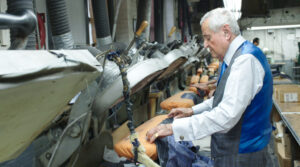Designed by artist Kerry James Marshall, the panels replace windows depicting Confederate Generals Robert E. Lee and Stonewall Jackson
For more than 60 years, stained-glass windows honoring Confederate Generals Robert E. Lee and Stonewall Jackson hung at Washington National Cathedral. But after a gunman shot and killed nine Black worshippers at a church in South Carolina in 2015, the cathedral decided to take them down.
Now, six years after the panels’ removal in 2017, the Washington, D.C. church has unveiled their replacement: four colorful windows depicting the struggle for racial justice. Titled Now and Forever, the panels show Black Americans holding protest signs bearing the words “Fairness” and “No foul play.” Most of the figures are on foot; one is seated in a wheelchair.
Artist Kerry James Marshall, who often depicts Black American life and history in his work, designed the stained-glass windows for the cathedral for just $18.65. That symbolic amount represents the year 1865, when the Civil War came to an end and Congress ratified the 13th Amendment, abolishing slavery in the United States.
/https://tf-cmsv2-smithsonianmag-media.s3.amazonaws.com/filer_public/e8/ce/e8ce486a-ca82-4df9-97ac-c82874c046d0/windows_installation_2nd_day-91.jpg)
Marshall worked with stained-glass fabricator Andrew Goldkuhle to bring his vision to life. With the protesters, he wanted to reflect the ongoing nature of racial justice.
“You have to strive for justice,” Marshall tells the Washington Post’s Marisa Iati. “It’s not something that is just there. It just seemed to me that if I was going to have the windows really embody the concept, they had to really address the activity.”
Washington National Cathedral is a Neo-Gothic house of worship for the Episcopal faith. It took 83 years to build, with construction lasting from 1907 to 1990. Today, it’s the second-largest cathedral in the U.S.
The church in northwest Washington has been the site of an array of important events, including presidential inaugurations and funerals. Martin Luther King Jr. gave sermons there, including one four days before he was assassinated.
The Confederate-themed windows had hung in the cathedral since 1953, when the United Daughters of the Confederacy donated them to the church. They featured Confederate battle flags and showed Lee “bathed in rays of heavenly light” and Jackson “welcomed by trumpets into paradise after his death,” writes Peter Smith for the Associated Press.
But the 2015 massacre at Mother Emanuel AME Church in South Carolina prompted church leaders to rethink the panels. After the shooting, photos emerged of the racist killer holding the Confederate battle flag and posing at Confederate heritage sites.
/https://tf-cmsv2-smithsonianmag-media.s3.amazonaws.com/filer_public/c1/fb/c1fbf30f-c771-4c32-8532-c9899207b494/wd_phillips_qt-13.jpg)
Ultimately, the church decided to remove the windows and put them into storage. The panels were “offensive” and “antithetical to our call to be a house of prayer for all people,” said the cathedral’s dean, the Very Reverend Randolph Marshall Hollerith, during Saturday’s unveiling ceremony.
“They told a false narrative, extolling two individuals who fought to keep the institution of slavery alive in this country,” he added, according to a statement.
The new windows, by contrast, “capture the resilience, faith and endurance of African Americans and our nation’s struggle with the original sins of racism and slavery,” per the cathedral’s website. They’ll soon be accompanied by an engraved poem by Elizabeth Alexander titled “American Song.”
Together, the windows and the poem tell the story of “collective movement, of progress, of people struggling and asserting the values of fairness for all,” Alexander tells the AP.
The leadership of the United Daughters of the Confederacy has remained silent about the cathedral’s windows. However, in a statement shared on the group’s website, President General Jinny Widowski argues that Confederate markers and statutes are “part of our shared American history and should remain in place.”
Get the latest stories in your inbox every weekday.
Recommended Videos
Window Cleaning One of Chicago’s Tallest Buildings
Chicago, home to some of the tallest skyscrapers in the world, throws some pretty unusual challenges at its daring window cleaners. From heavy winds and rough weather, to falcons nesting in the tower’s facade.




